Creating a flagship mobile app to meet Veterans’ needs
In early 2020, our team began a discovery sprint to assess the value of developing a mobile app on behalf of the Office of the CTO at the VA. Our work would prove very timely – it began at the start of the COVID-19 pandemic that would impact the lives of so many Veterans and their ability to access in-person VA services.
Only a few months after launching, the app has been downloaded to almost 300,000 devices. It has almost 10,000 ratings combined across Apple’s App Store and Google Play, with an average rating of 4.8 out of 5 stars in the Apple App Store and 4.6 in Google Play.
One enthusiastic Veteran said, “As someone who uses the VA website for disability claims and healthcare, this is a huge timesaver.” Another said, “…it allows the end-user almost seamless access to their rating, letters, claim status, and many more. I wish they had this five years ago.”
The app brings together previously siloed information about Veterans’ health and benefits into one centralized service available on iOS and Android. Using secure biometrics, Veterans can now quickly log in from their mobile device to:
- View upcoming healthcare appointments
- View COVID-19 vaccination records
- Send messages to healthcare providers
- Check the status of an open claim or appeal
- Review and update personal information
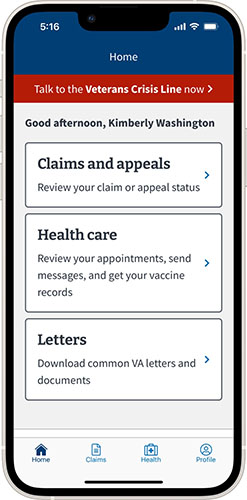
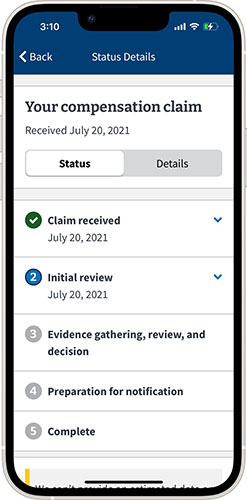
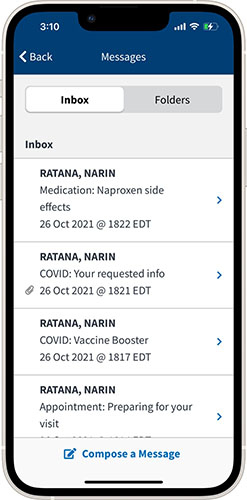
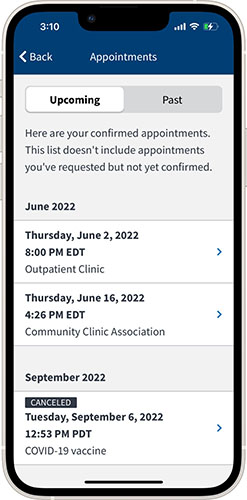
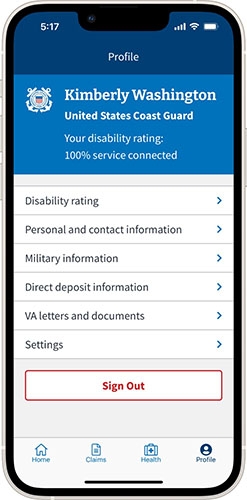
Determining the need for an app
We began our work by learning more about the problems users were facing to assess whether an app would be desirable to Veterans. Discovery centered around questions such as:
- Who are the Veterans most likely to use a VA mobile app and why?
- Beyond social media apps, what non-VA apps do they use most and why?
- How are Veterans currently managing their VA benefits and services?
During initial talks with Veterans about their experiences with VA digital services, we identified a number of core pain points that a mobile app could solve. These included long wait times for responses, having to manage fragmented information, a lack of transparency, and being unaware of existing VA services.
Further, we found that Veterans already access VA services via their phones; VA.gov data shows that 40% of traffic comes from mobile devices – a percentage that has only grown over time. As the COVID-19 pandemic severely restricted in-person interactions during the app development process, the need for easily accessible information via mobile devices became even more evident.
We combined these qualitative insights with quantitative data to conclude that there were, in fact, key friction areas for Veterans that a mobile app could help ease. For example, our interviews showed that a major challenge for Veterans was signing into their accounts online. A large portion of call center data confirmed that Veterans struggled to log in. With a cross-platform or native mobile app, we would be able to address this challenge by allowing users to sign in via their mobile devices’ built-in facial or fingerprint recognition biometrics.
Similarly, we combined the qualitative finding of Veteran frustrations accessing VA services online with quantitative analyses showing that there were a few quick actions frequently repeated on VA websites. By bringing together multiple, frequently accessed services into one consolidated place, we could create an app that would be much easier to navigate.
We continued the user research with tools such as co-design, in-depth interviews, and card sorting to determine what set of core features would be the most useful to Veterans in an app.
Defining the technical approach
We needed to understand what Veterans wanted from their app, and in parallel, recommend what technical approach to take.
On the technical feasibility side, we designed a series of experiments to better understand the following questions:
- What technical approach — fully native, cross-platform, hybrid, or progressive web application — would best fit the VA’s needs?
- What frameworks would best allow for the component re-use, UX flexibility, and ease of developer tooling?
While our UX team spoke with dozens of Veterans, our engineering team tested multiple frameworks by building a simple Hello World application. We wanted to balance development speed, ease of tooling, maintenance costs, infrastructure reuse, developer experience, and API strategy. The engineering team tested each framework by calling an existing open-source API from the VA’s API platform, building a screenflow to capture a document on camera, and recreating the Veterans Crisis Line panel. After testing a number of frameworks, we landed on React Native as the most promising framework for the app.
This flexible software framework allows VA to leverage the React skills that already exist in the agency. React Native also provides a smoother user experience than hybrid frameworks and allows custom native code when necessary. A cross-platform approach would allow the team to build one app using one codebase that could then be delivered to both the iOS and Android stores.
All these data points were the building blocks our team would use to design an app that put Veterans’ needs first.
Developing an app with Veterans’ requested features
In the spring of 2020, after our discovery and validation sprint concluded, Ad Hoc’s team, along with our partnering contractors and our stakeholders at the VA, began developing a prototype for the mobile app. Keeping in mind requirements from our research and Veterans’ feedback, the team built an accessible app centered around access to tools such as claims status, appointments, secure messaging, and profile.
Our team focused on an accessible user experience within our design and development processes. This meant that we made sure to:
- Develop a detailed accessibility test plan covering the implementation approach for each WCAG/508 requirement
- Create a library of design contrast requirements, as well as ensure generous font sizing and a design that let the content take center stage
- Include feature-specific accessibility requirements as part of the acceptance criteria of user stories
- QA test accessibility requirements such as color contrast, touch target size, and text resizing across multiple devices: screen readers, voice commands, and Bluetooth keyboards
Key features
Claims
Veterans can check claims and appeals statuses for both active and closed cases. They can also submit additional evidence the VA might be requesting. The ability to take pictures of documentation from their phone and upload them directly to a claim makes for a much more efficient process.
Appointments
Veterans can easily view or cancel existing appointments connected to their preferred calendar app and link the event to their preferred map app. They can also view a list of all past appointments and get push notifications for upcoming appointments.
Secure messaging
Veterans can communicate privately with their VA health care teams directly through the app. This provides more transparency and support through sometimes prolonged processes.
Vaccine records
Veterans can view their immunization records from VA, including which COVID-19 vaccination they’re received, along with the date, type of vaccine, and other key information.
Profile
Download letters
Veterans can receive common documents such as benefit summary and service verification letters, proof of service cards, and commissary letters.
Maintain profile information
Besides adding or changing basic personal and contact information, Veterans can use the app to check disability ratings and update direct deposit information for disability compensation and pension benefits.
General
Log in using biometrics
Veterans can securely sign in to the app and access their information using their mobile device’s built-in security features of either a fingerprint or facial recognition. Using biometrics as the log-in method greatly decreases authentication frustrations.
Access the Veterans Crisis Line
Using SMS integration, Veterans who are in crisis or who have concerns about someone who is can connect with caring, qualified responders through the 24/7 crisis hotline.
COVID-19 information
Veterans can access a basic FAQ document and a screening tool for routine and non-urgent questions that are specific to their needs.
Mapping the road ahead
Since launching the app in July 2021, we’ve been proud to see how warm its reception has been among Veterans. In support of the VA, and along with Liberty IT Solutions and Digital Foundry, we aim to continue to refine the app to improve usability and accessibility compliance and add new feature areas. Our roadmap is centered around prioritizing features around a series of core objectives:
- Allow Veterans to access their authenticated experience quickly and easily.
- Create a reliable, accessible, enjoyable, useful experience within the app.
- Enable Veterans to view transparent status updates and information from VA.
- Enable Veterans to quickly complete simple transactions for VA health and benefits services.
Ultimately, we hope that the flagship app will continue to be an invaluable tool for achieving its intended outcome: that every Veteran can easily manage their key VA health and benefits services through their digital channel of choice.
Related posts
- The 21st Century IDEA Act Playbook Part 3: Customized, mobile-friendly experiences
- Our four day discovery sprint with San Jose
- Ideas for creating mobile applications for Veterans
- Creating a COVID-19 dashboard to help the VA prioritize their response
- Imagining an app to simplify student loan forgiveness
- Why defining your product is an essential question in government digital services

